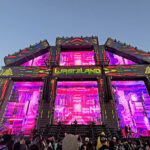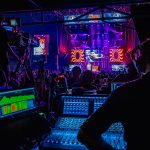The Bonnaroo Music and Arts Festival, now in its 16th year on the 700-acre site in Manchester, TN opened on an historical note with U2 as the opening night performer. It marked the first time in their 41-year career playing a festival in America, and only the second time they have ever performed on a festival stage. More than 65,000 people attended the four day event.
The U2 date at Bonnaroo fell in the middle of their summer stadium tour. Rather than scale down their existing rig, U2’s production designer Willie Williams asked Bonnaroo’s promoter Live Nation to recreate a rig that complemented what their stadium show tries to project. Executing that request, while fulfilling the needs of the other headliners on the main stage, eight secondary stages, and a host of peripheral stages that weekend fell to the hands of Bonnaroo’s production manager, Hadden Hippsley and Dizzy Gosnell, project manager and lighting designer for Bandit Lites, the festival’s lighting vendor for the What stage and the Which stage.
“It’s a juggling act we do every year,” says Hippsley, whose company, Lambda Productions, has provided the entire production team ever since the onset of the festival in 2002 and oversees productions requirements for artists’ needs for all stages for over 120 different musical acts in a four day period.

“Lighting is the most difficult challenge,” he continues. “Video is video, once you determine the size of the screens, and sound is sound, but lighting is very specific to the band and its musical presentation. Dizzy did a fantastic job of recreating their (U2) team’s design. That’s why Bonnaroo likes working with Bandit every year. It’s because of Dizzy’s approach and ability to assist working with all of the artists in trying to accommodate their needs as best as we can based on the constraints we face.”
Lambda works with 10 festivals a year. Four of them — Hangout, Bonnaroo, Firefly and Electric Forest — follow one right after the other for six straight weeks, from mid May to early July. Gosnell and Bandit are involved with several stages on all these festivals as well.

The Design Process
Hippsley notes that pretty much the day after Bonnaroo loads out, everyone is already thinking about the next year’s festival. The practical planning of the stage lighting design doesn’t happen until the promoters have locked down the bands appearing. This usually occurs around February, which is when Gosnell starts receiving lighting plots and designing the festival rig to handle all the multiple changes.
“I end up being sort of the ringmaster for all the rigging going on, with sound, video, visiting band systems, Bandit Lites and Bonnaroo,” say Gosnell. “There isn’t really a formula to it, other than we just scratch our chins and go, ‘Hmm… what can we do here,’ and also hit budget. It differs every year depending on the logistics for the main stage, and every day as well. It just gets blended. Sometimes it’s by an artistic thing, but generally, it’s a result of other bands bringing stuff and putting the permanent rig in such a way that we don’t have to drop and rehang two or three more times.”
Gosnell may describe the pre-production as simple, but the reality is a lot goes into the process. The Tetris-like act of overlaying multiple plots and layering them into the festival design and the grid of the permanent stage onsite, requires quite a bit of “mental gymnastics.”

Hippsley, on the production end, deals with the challenge posed by the fact that Bonnaroo is essentially a 24 hour event, once doors open. “Each stage has a day and night manager because we work 24 hours with shows day and night between loading bands in out,” he says. “The peripheral stages throughout the campsites and cultural areas (known as Pods) have the same schedule. It really never stops.”
As is usually the case, the Friday night headliner at Bonnaroo loads in one or two days early to have plenty of time for rehearsals and soundcheck before the festival opens. U2 was no exception.
The crew’s challenge Friday night, however, was to load out the production elements that U2 brought in, then rearrange and re-hang the festival lighting system. To help make this easier, the production team created a design that opened up gaps to hang both Chance the Rapper’s elements and the Red Hot Chili Peppers rig. Both bands could be loaded in immediately after U2’s load-out.
“Willie’s design was a symmetrical rig of multiple 24-foot Tyler truss loaded with nothing but [Martin] MAC Vipers,” notes Gosnell. “The downstage truss had Vipers as well, but I added [Vari-Lite] VL washes to give the other bands a bit of a meat and potatoes in the rig to use. We combined the Tyler truss, creating a more symmetrical rig to make them longer, and overhung Robe BMFL’s on them to create more depth and layers. Atomic 3000 strobes with scrollers were added as well.”

A team of riggers concentrated on the festival re-hang while a separate team hung the two incoming systems. The 40-by-80-foot LED screen provided by Screenworks for U2’s show had to be reduced to a 30-by-60-foot screen to accommodate incoming production.
As noted, Saturday night had two co-headliners, Chance the Rapper and the Red Hot Chili Peppers. The challenge there was to come up with a design based on the limits of the stage and still give each individual artist their own thumbprint that worked with the time they had for load-in and set changes.
Fortunately, as Gosnell and Hippsley were happy to discover early on in the design process, the rigs for the two Saturday night headliners meshed. “We got lucky,” said Hippsley. Chance’s rig was concentrated downstage, while RHCP video and lighting hung upstage of Chance’s gear. “Once we got all the lights in the air RHCP did a line check, then we cleared the deck for Chance to do their line check and programming. Finally, we followed that by loading in the other four bands that performed on the main stage Saturday.”
Saturday night was pretty much the same process, but fortunately, it was as if only one headliner had to load in. “Almost like a day off,” chuckles Hippsley. Another pleasant bonus: “All of the headline acts this year had great teams surrounding them.”

A Bit of History
While Hadden Hippsley’s name is most often associated with the Bonnaroo Festival, he is the first to point out the massive collective effort that goes into the success of this festival each year. “The neat thing about Bonnaroo is, there is a core team of department directors, and there are many departments. It is a giant team effort to produce the event year-to-year, involving a process that starts at least nine months ahead of the festival.”
Before the first Bonnaroo Festival was held in 2002, festival founders AC Entertainment partnered with Superfly Productions to stage the first shows. The organizations had been formed mainly to produce after-events for the New Orleans Jazz Festival. With the idea of creating a large festival akin to the historical Woodstock and Atlanta Pop Festival, they reached out to the Phish organization, which had been doing festivals of their own. The timing was right, as Phish were on a hiatus. Russ Bennett, their visual designer; Chris Crowl, who managed food, beverages and crafts at the Phish Festivals; and production manager Hippsley, who also ran his own production company, Lambda Productions, all signed on the help create Bonnaroo.
In 2007, the festival bought the land, started making improvements to the lot, and later contracted Brown United to build the permanent main stage. Clark Reder Engineering was brought in to verify the structural integrity of the massive construction which can hold 80,000 pounds. In fact, Clark Reder stamps all of the design plots Gosnell creates for Bonnaroo and completes a visual inspection every year before doors open.
As a founding member of the Event Safety Alliance, Hippsley has seen ESA’s impact on the industry become a huge success. “The goal we kept vocalizing is attend an event, enjoy it, and then return home safely to your families, and it has been embraced,” he says.

The impact has probably been more powerful than any of the founders could have imagined, and the festival revolutionized the industry in just a few short years. What Bonnaroo, Phish, and Linkin Park through Jim Digby have always done, regardless, now stands as the model and set the bar. The act of following best practices is supported not only by the insurance industry, but everybody in the industry from promoters to festivals, to touring agencies.
“The great thing with the Bonnaroo main stage,” says Hippsley, “is that it was designed to be very production friendly. It’s a giant stage with a huge amount of weight capacity to the roof with a level stage floor and loading dock with cable troughs surrounding its perimeter.”
In 2016, Live Nation bought the festival, with Superfly remaining as the management team. “Now we all work for C3 [Presents], the festival arm of Live Nation,” says Hippsley.
The Lambda team oversees production of all of the stages, sound and lighting. Site operations, security, ticketing, toll booths, and campgrounds all have their own departments.
Because of the grand size of Bonnaroo, there are multiple production venders on the event. “In my opinion, it is difficult for one vendor to do a great job individually. Even if they have the gear, every vendor has to provide at least two shifts of staff because of the overnight programming going into the wee hours of the morning. Very few vendors have the high level of staff to cover all those shifts. After all we are well into the summer touring season when Bonnaroo takes place. So by design, we involve several different vendors for the success of those vendors as well as the festival.”

How It’s Done
Every year, Superfly gathers all department heads for multiple meeting think tanks where new concepts and ideas are tossed around based on customer feedback and ideas from people in the room. Cat Tooley, event VP of operations and production for Superfly, heads up these think tanks. Throughout pre-production, and once onsite, Hippsley reports directly to her.
Besides the main and secondary stages, Bonnaroo has eight other sizable stages and other peripheral stages throughout the site, including those set up in the campgrounds, which are activated throughout the night with programming. Some of these are sponsorship-activation type stages, and some are just festival-created stages.
The festival divides the campgrounds into Pods. Many have different types of activation, with a unique design. These serve two purposes. First, it helps someone know where they are camping on the site based on what Pod they are near. Second, each one creates a sort of cultural experience among the campers in each of those Pods, which almost become themed villages. “It is a way for us to centralize a lot of assets such as medical, security, showers, information booths,” notes Hippsley. “The other great advantage is how these various areas become a cultural location.
“We have a team of stage managers specifically dedicated to those peripheral stages.” Hippsley continues. “We try to continually teach all the stage mangers that we are here to help bands be successful. We want bands to have their own thumbprint. Part of the musical experience is the visual aspect of the show. We want to give the audience that unique experience with each band.”

Another sign of a well-run festival is the number of freelancers who make sure their schedule is open to return each year. “A lot of our stage managers often tour with bands throughout the world. We are just amazed they keep coming back,” Hippsley adds.
“What’s very fortunate for Lambda, speaking selfishly for my company, is that the festivals we’re fortunate enough to work with all follow the same philosophy Bonnaroo has. Bonnaroo was one of the first festivals in the country and kind of set the model, in my opinion, for all festivals to follow, and that is huge team effort. Very rarely is there yelling, screaming and fighting. You know just by looking at the schedule, how hard the hours are and demanding the job is. It’s a very enjoyable experience because of the team effort and respect that our department gives other departments, as well as the support we receive.”
In closing Hippsley notes, “Every festival has challenges, but thanks to team efforts, those challenges are never overwhelming and almost always pleasant to work through. It’s a ton of work, but it’s enjoyable when you’ve got people like that working around you. That’s not always the case, but this year was phenomenal.”

2017 Bonnaroo Music and Arts Festival
Crew
- Production Coordinator: Hadden Hippsley
- Lambda’s Business Manager: Mary Ann Hippsley
- Production Coordinator/Night Manager: Jerry Market
- Office & Database Manager: Anna Giordano
- Labor Manager: Pete Luther
- Main Stage Production Manager: Mark Immerman
- Main Stage Night Manager: Ryan Tilke
- Second Stage Manager: Joe Gordon
- Second Stage Night Manager: John Ficklen
- Tent 1 Stage Manager: JR Leake
- Tent 1 Night Manager: Josh Levin
- EDM Stage Manager: Justin Wilcox
- EDM Night Manager: Trevor Bone
- Tent 3 Stage Manager: Rob Weil
- Tent 3 Night Manager: Paul Gussack
- Peripheral Manager: John Monroe
- Peripheral Assistant Manager: David Netzel
- Peripheral Night Manager: Lane Lantis
- Peripheral Roamer: Matt Rowe
- Comedy/Cinema Stage Manager: Rich Pluger
- Comedy/Cinema Night Manager: Lisa Vinciquerra
- Who Stage Manager: Sami Slovy
- Christmas Barn Stage Manager: Dave Davies
- Miller, Press & Ford Stage Manager: Joe Plovack
- Crossloads Manager: Carl Coyne
- Crossloads Night Manager: Corey Carlson
- Solar Stage Manager: James Keane
- Silent Disco Manager: Ryan Dowd
Gear
What Stage (Main Stage):
- 3 grandMA2 full consoles
- 2 grandMA2 NPUs
- 308’ Tyler truss
- 16 Tyler truss end pick point
- 60’ A Type 10’
- 90’ 12” x 10’ truss
- 90 Martin MAC Viper Spots
- 32 Robe BMFLs
- 39 4 Lite DWE Inline
- 12 Vari-Lite VL3500 Wash
- 6 Lycian M2 long throw spots
- 4 Lycian M2 medium throw spots
- 27 Atomic 3000 strobes
- 27 Atomic strobes w/scrollers
- 6 Atomic Strobe PSU
- 24 GRN moving wash fixtures
- 4 Lightning Strikes
- 35 1-ton motors
- 4 ZR 44 smoke machines
- 4 Hazer fans
- 1 36” Mirror Ball
Crew
- Lighting Co: Bandit Lites/Dizzy Gosnell
- Crew: Sam Morgan, Craig Richter, Shawn Worlow, Savannah Harden, Scott Wesson
“Which” Stage
- 5 grandMA2 full consoles
- 3 grandMA2 NPUs
- 135 A type truss
- 60’ Tyler truss
- 210 12” truss
- 13 4 Lite DWE 2×2
- 20 Vari-Lite VL3500 Wash
- 28 Vari-Lite VL3000 Spots
- 12 Claypaky Sharpys
- 48 Claypaky Mythos
- 24 Martin MAC Auras
- 8 Elation Color Chorus 72’s
- 38 Solaris Flares
- 26 1-ton motors
- 4 Base Hazer Pro units
- 4 Hazer fans
- 2 Black drape (25’ x 25’)
Crew
- Lighting Co: Bandit Lites/Dizzy Gosnell
- Crew: Ryan Waldron, Patrick Sieg, Elizabeth Weller
Tower
- 1 grandMA2 Full console
- 8 SGM G-Spots
- 32 Claypaky Sharpys
- 2 ETC 72-way 2.4K dimmers
Crew
- Lighting Co: Bandit Lites/Dizzy Gosnell
- Crew: Wayne Lotoza, Michelle Saintey, Chase Strickland


